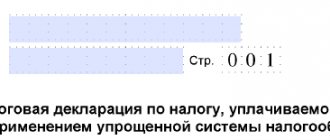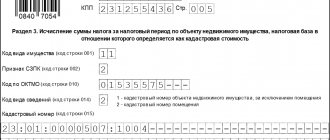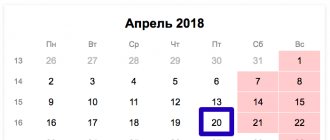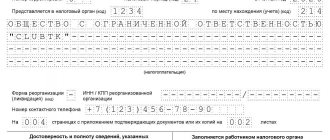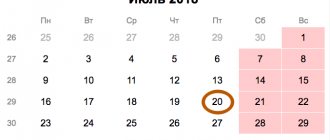Who “rents” for VAT?
The obligation to submit a VAT return lies with (clause 5 of Article 174 of the Tax Code of the Russian Federation):
- Individual entrepreneurs and companies using OSNO (general taxation system), except for those exempt from VAT under Art. 145-145.1 Tax Code of the Russian Federation;
- VAT tax agents (including freight forwarders, developers, etc.);
- special regimes and merchants exempt from duties as VAT payers (if they have issued an invoice with VAT).
The VAT return is submitted quarterly, almost always in electronic form (with rare exceptions). The procedure for filling it out, the form and electronic format were approved by order of the Federal Tax Service of Russia dated October 29, 2014 No. MV-7-3/ (as amended on December 20, 2016). The declaration form is expected to be updated in the near future.
Main reporting periods for VAT
Report for VAT - this phrase may imply several actions. In particular, it means:
- Send the VAT declaration to the tax authorities via TKS.
- Send the invoice log to the controllers.
Find out who has this responsibility by following this link..
- Collect a set of documents and submit them, together with the indirect tax declaration, to the tax authority (when importing material assets from the EAEU).
The indirect VAT declaration form can be downloaded here.
The reporting dates for each specified case are shown in the diagram:
We will introduce you further to the specific reporting dates for VAT in 2021 (including the deadlines for submitting VAT for the 1st quarter of 2021).
Composition of the report
The declaration consists of a title page and 12 sections. Its composition is indicated in the table:
| Section number of the VAT declaration | Purpose of the section |
| 1 | Summary section containing the total VAT amount |
| 2 | Designed to determine the amount of tax paid by tax agents |
| 3 | Contains information that allows you to calculate VAT on transactions that are taxed at rates of 10%, 18% or calculated rates |
| 4 | To be completed in case of transactions taxed at 0% rates |
| 7 | Included in the declaration if there were transactions not subject to VAT under Art. 149 Tax Code of the Russian Federation |
| 8-9 | The data specified in the purchase book and sales book are reflected. |
| 10-11 | Prepared by tax agents (contain information from the invoice journal) |
| 12 | To be completed by taxpayers who are exempt from VAT but have issued VAT invoices |
However, it is not necessary to include all of these sections in the declaration. Let us explain why with an example.
Etude LLC uses OSNO. In the 1st quarter of 2021 the company:
- sold goods in the amount of 3,788,133 rubles. (including VAT = RUB 577,851);
- received invoices from suppliers, the total amount of VAT on which was 355,021 rubles.
The VAT return for the 1st quarter will include a title page, sections 1 and 3. In addition, you will need to upload information from the purchase book and sales book (sections 8 and 9) into the declaration preparation program.
This composition is explained by the fact that, in addition to the sale of goods at a rate of 18%, the company did not carry out other operations (taxed at a rate of 10% or 0%), did not act as a tax agent, etc.
The computer program with which the declaration is drawn up will itself calculate the VAT (payable or refundable) using the simplest formula:
VAT = 577,851 ─ 355,021 = 222,830 rubles.
How to fill out a VAT return for the example considered, see the sample.
When to submit a VAT report to the Federal Tax Service in 2021?
Documentation on value added tax relates to the tax return, so the 2021 VAT report is submitted to the Federal Tax Service along with other documentation. The law of the Russian Federation provides for its delivery based on the results of all quarters of the current year. The full procedure and exact deadlines are described in Article 174 of the Tax Code of the Russian Federation. The benefits for the 2021 VAT report are also listed there.
Reports are submitted to the tax service within the following deadlines:
- 4 sq. 2021 – until 01/25/17;
- 1 sq. 2021 – until April 25 of the same year;
- 2 sq. – until July 25, 2017;
- 3 sq. – until 25.10.17.
The company will report for the 4th quarter in 2021 (until January 25). There are 3 forms for submitting documents: by visiting a Federal Tax Service office in person, by mail, and by telecommunications. Submitting your 2018 VAT report online is much easier and faster.
Due to the likelihood of reports being returned for revision, it is necessary to prepare them in advance. Then the accountant will have time to check any errors and inaccuracies found.
What calculations will be needed to fill out the VAT return?
Before the figures for calculating the tax are included in the declaration, it is necessary to carry out preliminary actions:
- Check the accounting data with the information reflected in the accounting registers. You will need account information:
- 19 (amounts of deductions);
- 60, 62 and 76 (correspondence of the amounts of advances and related VAT);
- 90, 91 (sales volumes);
- 68 (participating in the calculation of the tax amount and the final result of the declaration).
- Conduct a preliminary analysis of deductions:
- calculate the total amount of deductions (DC) that you are entitled to claim based on the results of the 1st quarter;
- compare it with the safe share of deductions (SDR), determined by tax authorities by region;
- assess the possible risks and consequences of reflecting the calculated amount of deductions in the declaration if B > BDV.
The Federal Tax Service recently once again updated data on BFV (as of 02/01/2018). By region, the spread ranges from 50.9 (Baikonur) to 125.7 (Nenets Autonomous Okrug).
If deductions exceed the BDV, do not forget about your right to partially include VAT in the deduction (clause 1.1 of Article 172 of the Tax Code of the Russian Federation): VAT on goods, works and services can be deducted in parts for 3 years. However, this rule does not apply to VAT deductions on fixed assets, intangible assets and equipment for installation - the deduction for them is made in full after registration (clause 1 of Article 172 of the Tax Code of the Russian Federation).
What to pay attention to
It is important to pay special attention to deductions - even before sending the VAT return to the Federal Tax Service. It should not include data from “dangerous” invoices (containing errors, received from dubious counterparties, etc.). Thanks to the ASK VAT system, controllers identify any discrepancies in accrued tax and deductions. With this system:
- unscrupulous taxpayers are identified;
- illegal VAT deductions are excluded.
Thanks to the connection of ASK VAT to the banking system:
- the search for merchants dependent on each other is made easier;
- the movement of amounts withdrawn from taxation is monitored.
Inconsistencies identified by the system in the declaration will entail:
- submission of explanations to the Federal Tax Service (they also need to be transmitted to controllers via electronic communication channels, like VAT);
- submission of an updated declaration.
Another equally important issue when preparing a declaration is the correct indication of codes for types of transactions. If the code is used incorrectly or is not reflected at all, the declaration will not pass format-logical control, resulting in:
- it will be considered not accepted by the controllers;
- a fine may follow (if you do not have time to correct the erroneous declaration before the reporting deadline);
- you can provoke an unscheduled tax audit;
- VAT deduction may be denied.
Transaction codes are replenished and updated from time to time, so it is necessary to regularly monitor their relevance (letter of the Federal Tax Service dated January 16, 2018 No. SD-4-3/).
Before sending the declaration to the inspectorate, check it for errors. Use the control ratios for this (letter of the Federal Tax Service dated March 23, 2015 No. GD-4-3/). It is also necessary to monitor their relevance - their last update was in the letter of the Federal Tax Service dated 04/06/2017 No. SD-4-3/
Filling out the remaining sections of the declaration
The remaining sections and appendices to them are present in the report only if there are grounds for filling them out:
- The procedure for filling out section 2 of the VAT return requires the completion of this part of the report if the business entity fulfills its obligations as a tax agent for the tax. The number of sections must correspond to the number of counterparties in relation to which the business entity acts as a tax agent.
- The procedure for filling out section 4 of the VAT return requires filling out this block of the report if there are grounds for applying a zero tax rate. The norm is relevant only for those persons who can document their right to preferential taxation.
- Section 5 is filled in by “zeros” who have received the right to apply a 0% rate in the current reporting interval if they have claimed deductions.
- Section 6 is intended for transactions for which the justified application of the zero rate has not been confirmed. That is, if information on transactions with zero VAT is entered in section 4 of the VAT return if there is documentary evidence of the competence of such actions, then in the absence of confirmation, the amounts for transactions are included in section 6.
- Section 7 covers the range of transactions exempt from taxation - this section is required to be completed by the taxpayer if all of his transactions in the period were not subject to VAT.
- Section 10 of the VAT return and section 11 are prepared by freight forwarders, developers and persons who work under commission contracts or agency agreements.
- Section 12 is completed by issuers of invoices who are not VAT payers, or are exempt from taxpayer obligations, or if the invoice was issued for transactions not subject to VAT.
Read also: Zero VAT return – which sheets to submit?
The report should contain only those sheets that contain data; there is no need to number empty pages and submit them to the tax authority. The deadline for filing the declaration is the 25th day of the month following the reporting quarter.
Read also: Payment of VAT in 2021: payment deadlines
Declaration and changes in legislation
The latest legislative innovations also need to be taken into account when preparing the VAT return for the 1st quarter. For example, from 01/01/2018, buyers of raw animal skins (as well as scrap, waste of ferrous and non-ferrous metals, secondary aluminum and its alloys) have an obligation to reflect the corresponding amount of VAT in the declaration and pay it to the budget. That is, in this situation, the buyer is obliged to perform the functions of a tax agent (letter of the Federal Tax Service dated January 16, 2018 No. SD-4-3/):
- determine the amount of VAT using the calculation method;
- indicate on line 060 of section 2 of the VAT return the total amount of tax (taking into account possible deductions for transactions with raw hides and scrap, and amounts of restored VAT);
- transfer taxes to the budget.
Legislators periodically supplement and adjust VAT legislation, so it is important to regularly monitor such changes and take them into account when filling out the declaration.
Results
Not only payers of this tax, but also special regime officials are required to submit a VAT return if they issued an invoice with an allocated VAT amount in one of the months of the first quarter (and in other cases established by law). Failure to submit a declaration on time may result in a fine under Art. 119 of the Tax Code of the Russian Federation.
Sources: Tax Code of the Russian Federation
You can find more complete information on the topic in ConsultantPlus. Free trial access to the system for 2 days.
The declaration is completed - what next?
The amount indicated in the declaration must be included in the budget in a timely manner. To do this, it is important to follow the legally established rules. Clause 1 Art. 174 of the Tax Code of the Russian Federation states that the tax amount calculated in the declaration is divided into 3 parts and transferred for the 1st quarter no later than:
- 25th of April;
- May 25;
- June 25.
However, you can not split the payment, but transfer VAT according to any scheme suitable for you (½ the amount on the first two dates, the entire amount at once on the first payment deadline, etc.). There is no prohibition in the Tax Code of the Russian Federation on the use of such payment schemes. The main thing is that the tax goes to the budget in full and in an amount not less than the minimum amount allowed for each period.
Example:
In the VAT return for the 1st quarter of Triathlon LLC, the amount payable was 466,230 rubles.
Here are several options for payment schemes for Triathlon LLC:
| Last payment date | Option #1 | Option No. 2 | Option No. 3 | Option No. 4 |
| 25.04.2018 | 155 410 | 310 820 | 466 230 | 300 000 |
| 25.05.2018 | 155 410 | ─ | ─ | 10 820 |
| 25.06.2018 | 155 410 | 155 410 | ─ | 155 410 |
Triathlon LLC is characterized by uneven revenue receipts across the months of the quarter (peak revenues occur in the first half of April, and then a lull until June). Therefore, three of the presented options are suitable for him:
- No. 2 - transfer at once twice the minimum allowable amount of VAT on the first payment deadline, do not pay in May and send the remaining third of the tax to the budget in June;
- No. 3 - pay the budget in full on the first payment date;
- No. 4 - distribute VAT based on payment capabilities with payment of most of the tax in the first term and additional payment in the second term of the amount missing to the minimum allowable.
However, splitting payments is not always allowed and the company may be deprived of the opportunity to choose payment schemes. Let's explain with an example:
IP Gordeev S.L. and Gorets LLC sent payment slips to the bank on April 20, 2018 to transfer VAT for the 1st quarter:
| VAT payer | Applicable taxation system | Amount of VAT payable according to the declaration, rub. | The VAT amount indicated in the payment order (due for payment no later than 04/25/2018) |
| IP Gordeev S.L. | BASIC | 456 078 | 152 026 |
| LLC "Gorets" | simplified tax system | 1 386 123* | 462 041 |
*In the 1st quarter, Gorets LLC issued an invoice with VAT in the amount of RUB 1,386,123.
As a result, VAT paid to the budget by entrepreneur S.L. Gordeev (in the amount of 1/3 of the amount indicated in the declaration), safely fell into the budget, and the tax authorities had no complaints against this payer.
And Gorets LLC, which calculated VAT payable according to the same principle as IP Gordeev S.L. (under clause 1 of Article 174 of the Tax Code of the Russian Federation), received from the Federal Tax Service a requirement to pay penalties for late payment. Why?
The company did not take into account the norms of clause 4 of Art. 174 of the Tax Code of the Russian Federation, according to which the simplifier, when issuing an invoice with allocated VAT, is obliged to transfer it in full to the budget (splitting the payment is not allowed).
Not only the payer himself, but also another person can transfer tax to the budget (the rules for this option of settlement with the budget are described in the order of the Ministry of Finance of Russia dated April 5, 2017 No. 58n).
IMPORTANT! Identification of errors in the declaration after its submission will require the following actions from you:
- mandatory filing of an adjustment return (if the tax was underestimated);
- additional payment of arrears and penalties (before filing an updated declaration) - this will help avoid a fine (subclause 1, clause 4, article 81 of the Tax Code of the Russian Federation).
If the error in the declaration did not underestimate the tax payable, whether or not to submit an updated declaration, you decide for yourself (clause 1 of Article 81 of the Tax Code of the Russian Federation).
Read also
27.12.2017
Instructions for filling out a VAT return: example
LLC "Group" in the third quarter of 2021 carried out the following operations:
- Purchase of raw materials for production needs in the amount of 26,963 rubles, including VAT at a rate of 18% (cost excluding tax 22,850 rubles and VAT - 4,113 rubles). For this transaction, invoice No. 110 dated 08/01/2018 was received.
- A lathe for processing wood was purchased at a cost of 225,026 rubles, including VAT at a rate of 18% (cost without tax was 190,700 rubles and VAT 34,326 rubles). The operation is confirmed by invoice No. 215 dated September 12, 2018.
- Sold 5 sets of unused equipment. The transaction amount is 944,590 rubles, including VAT (18%) in the amount of 144,090 rubles.
The procedure for filling out a VAT return requires the mandatory completion of the title page and section 1. The remaining sections are filled out only if the data is available.
At the top of the title page, the taxpayer’s TIN and checkpoint numbers are entered. In the field reserved for the adjustment number, enter 0, since the declaration is being submitted for the first time. The tax period is indicated by the corresponding code; the third quarter corresponds to the code “23”. Filling out the VAT tax return continues by indicating the code at the location (all necessary codes are selected from directories in Appendix No. 3 to the Filling Out Procedure) and the code of the main activity according to the OKVED2 directory. The design of the title page is completed by indicating who is submitting the report (the taxpayer or his representative), the date and signature of the head (representative).
The further procedure for preparing a VAT tax return includes filling out the relevant sections. It will be more convenient to enter data in the following order:
- Section 8. Data is entered into it from the purchase book. In our example, there were two purchase cases (raw materials and a machine were purchased), which means that this section must be filled out twice (all purchase and sale transactions must be reflected separately, so there will be as many sheets with section 8 as the number of acquisition transactions recorded).
- The procedure for filling out a VAT tax return obliges business entities, if there are sales, to fill out Section 9. Information from the sales book is entered into it; the company had one such transaction (sale of equipment).
- Section 3, which collects data on input and output VAT based on information from sections 8 and 9.
- Section 1, which summarizes tax liabilities.
The rules for filling out a VAT return when completing Section 8 require that you indicate the numbers and dates of invoices, payment documents, and details of counterparties. The cost of the transaction is indicated as a total amount including tax; the amount of VAT included in the price is shown separately. On the last page of section 8, line 190 summarizes the amount of input tax on transactions in the purchase book, in our example it is 38,439 rubles. (RUB 4,113 + RUB 34,326).
A similar filling approach is applied to section 9. Here we indicate the amount of VAT on sales - 144,090 rubles.
The tax calculation in section 3 of the VAT return begins with sales data. Line 010 contains information on the total amount of proceeds from the sale and tax. In our example, in column 3 of this line you need to indicate 800,500 rubles. (cost without VAT, since it is the tax base from which the tax liability will be calculated that is reflected), in column 5, opposite the 18% rate, the amount of VAT is entered - 144,090 rubles, which corresponds to the amount of the tax liability for sales transactions. Line 118 summarizes the total for all types of sales transactions in terms of the total amount of output tax.
The second page of Section 3 displays information about purchase transactions. The total amount of input VAT is entered in line 120 - 38,439 rubles. In the example, transactions were carried out without advance transfers. In the VAT return - line 130, the filling procedure provides for the reflection of the tax amount only if there is VAT invoiced on prepayments in the period under review. Line 190 summarizes the input VAT subject to deduction, and line 200 indicates the estimated amount of the tax liability - 105,651 rubles. (144,090 – 38,439).
The final stage of filling out the declaration is transferring the summarized data to section 1. The OKTMO and KBK tax code is indicated here. The amount of tax payable is entered in line 040 - 105,651 rubles.
